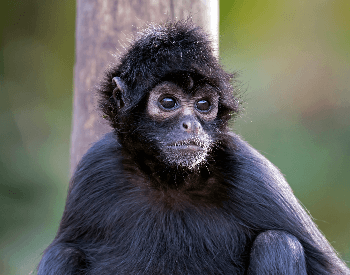A look at “10 Surprising Facts About Spider Monkeys” Spider monkeys are fascinating creatures that inhabit the dense forests of Central and South America. With their unique physical features and playful nature, spider monkeys have captured the interest of scientists and animal enthusiasts alike.
In this article, we will explore ten surprising facts about spider monkeys, shedding light on their behavior, habitat, and remarkable adaptations.
Table of Contents
- 1 10 Surprising Facts About Spider Monkeys
- 2 1. The Spider Monkey’s Physical Appearance
- 3 2. Spider Monkeys: Masters of the Treetops
- 4 3. The Importance of Prehensile Tails
- 5 4. Social Structure and Communication Among Spider Monkeys
- 6 5. Spider Monkeys: Fruitarians of the Forest
- 7 6. Spider Monkeys and Seed Dispersal
- 8 7. Spider Monkeys: Agile and Acrobatic
- 9 8. Aerial Travel: Spider Monkeys’ Unique Mode of Transportation
- 10 9. The Endangered Status of Spider Monkeys
- 11 10. Spider Monkeys and Human Interactions
- 12 Conclusion
- 13 FAQs
10 Surprising Facts About Spider Monkeys
Spider monkeys are New World monkeys found in the tropical and subtropical rainforests of Central and South America. Their name is the result of their spiderlike appearance when they hang by their extra long prehensile tails from the bow of a tree.

There are seven species and seven subspecies of spider monkeys, and all are at risk of extinction due to habitat loss and hunting. Spider monkeys are primarily herbivores and frugivores that are quite social and tend to live in large groups. From their lack of opposable thumbs to their ability to cover large distances with a single swing, discover the most fascinating facts about spider monkeys.
1. The Spider Monkey’s Physical Appearance
Spider monkeys are easily recognizable due to their long, slender limbs and tail. They have a lanky body structure, with males weighing around 18 to 20 pounds and females slightly lighter at 13 to 15 pounds. Their arms are significantly longer than their legs, allowing them to navigate through the treetops with remarkable agility.
2. Spider Monkeys: Masters of the Treetops
Spider monkeys are arboreal creatures, spending the majority of their lives high up in the trees. Their limbs and tails are adapted for swinging and brachiation, enabling them to move swiftly through the canopy. With their long arms, spider monkeys can cover distances of up to 40 feet in a single swing.
3. The Importance of Prehensile Tails
One of the most remarkable features of spider monkeys is their prehensile tails. These tails act as an extra limb, providing them with a strong grip on tree branches. Spider monkeys use their tails to hang from branches, allowing them to reach fruits and navigate the treetops effortlessly.
4. Social Structure and Communication Among Spider Monkeys
Spider monkeys live in large social groups, consisting of both males and females. They exhibit a complex social structure, where males compete for dominance and access to females. Communication among spider monkeys is vital for maintaining group cohesion. They use various vocalizations, facial expressions, and body postures to convey different messages.
5. Spider Monkeys: Fruitarians of the Forest
Spider monkeys primarily feed on fruits, making them frugivores. Their diet consists of a variety of fruits, including ripe and unripe ones. By consuming a wide range of fruits, spider monkeys play a crucial role in seed dispersal, contributing to the health and diversity of their forest ecosystem.
6. Spider Monkeys and Seed Dispersal
As spider monkeys travel through the forest, they ingest fruits and seeds. These seeds pass through their digestive system and are expelled in their feces, often in different locations. This process aids in the dispersal of seeds, allowing plants to colonize new areas and regenerate the forest.
7. Spider Monkeys: Agile and Acrobatic
Spider monkeys are known for their remarkable agility and acrobatic abilities. They can perform astonishing leaps and mid-air somersaults while swinging through the trees. Their flexible limbs and muscular bodies enable them to navigate the forest canopy with grace and precision.
8. Aerial Travel: Spider Monkeys’ Unique Mode of Transportation
Spider monkeys have a fascinating mode of transportation known as “aerial travel.” They traverse the forest by swinging from branch to branch using their long arms and prehensile tails. This form of locomotion, called brachiation, allows them to cover long distances efficiently and quickly. Spider monkeys can reach speeds of up to 35 miles per hour while airborne, effortlessly gliding through the treetops.
9. The Endangered Status of Spider Monkeys
Despite their remarkable abilities, spider monkeys face numerous threats that have led to their endangered status. Habitat loss due to deforestation, logging, and agriculture is a significant challenge for their survival. The destruction of their natural habitat greatly reduces their access to food and disrupts their social dynamics. Additionally, spider monkeys are hunted for bushmeat and captured for the illegal pet trade, further impacting their population numbers.
Conservation efforts are underway to protect spider monkeys and their habitats. National parks, reserves, and sanctuaries have been established to provide safe spaces for these remarkable creatures. Educational programs and community involvement play a crucial role in raising awareness about the importance of preserving spider monkeys and their ecosystems.
10. Spider Monkeys and Human Interactions
Spider monkeys have had various interactions with humans throughout history. In some indigenous cultures, spider monkeys hold spiritual significance and are revered as symbols of wisdom and agility. However, the increasing encroachment of human activities into their habitats has led to conflicts.
It is essential for humans to recognize the impact of their actions on spider monkeys and take steps to coexist harmoniously. Respecting protected areas, supporting sustainable agricultural practices, and avoiding the purchase of products derived from illegal logging can contribute to the conservation of spider monkeys and their fragile ecosystems.
Conclusion
Spider monkeys are extraordinary creatures with unique adaptations that allow them to thrive in the treetops of Central and South American forests. From their physical appearance to their aerial acrobatics, spider monkeys continue to captivate our imagination. However, their survival is under threat due to habitat loss, hunting, and the illegal pet trade. It is our responsibility to protect these incredible primates and ensure their existence for future generations to appreciate.
FAQs
1. Are spider monkeys dangerous? Spider monkeys are generally not dangerous to humans. They are shy and prefer to avoid confrontations. However, like any wild animal, they may act defensively if they feel threatened.
2. How long do spider monkeys live? In the wild, spider monkeys have an average lifespan of 20 to 25 years. However, they can live longer in captivity, with some individuals reaching up to 40 years of age.
3. Can spider monkeys be kept as pets? No, spider monkeys are wild animals and should not be kept as pets. Keeping them in captivity is illegal in many countries and poses significant challenges in terms of their welfare and conservation.
4. Do spider monkeys communicate with each other? Yes, spider monkeys have a complex system of communication. They use vocalizations, facial expressions, and body postures to convey different messages within their social groups.
5. How can I contribute to the conservation of spider monkeys? You can support organizations and initiatives that work towards the conservation of spider monkeys and their habitats. Additionally, raising awareness about the importance of protecting wildlife and their ecosystems is crucial in promoting their conservation.









